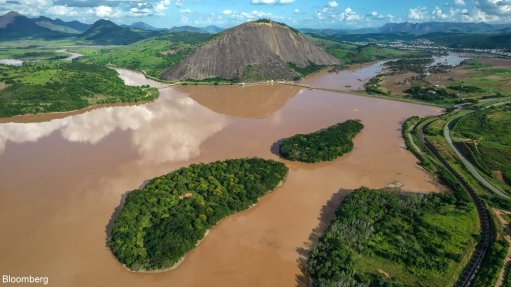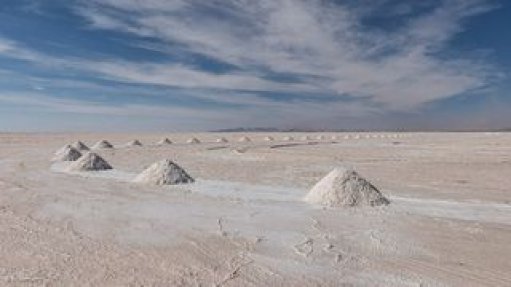Shanta reveals ‘encouraging results’ for West Kenya exploration project
Aim-listed gold producer Shanta Gold has revealed “encouraging results” in an exploration update for the West Kenya project, in Kenya, for the fourth quarter of last year and the first quarter of this year.
“At Ramula, the 2 911 m of assays reported today should allow us to convert inferred resources to indicated category resources. Results from the 1 886 m of assays at our early-mid-stage targets at both Miruka and Anomaly 22 have demonstrated economic range mineralisation, confirming the continuity of the mineralisation," Shanta CEO Eric Zurrin said on April 16.
The drilling programmes started last year and have continued through the first quarter of this year, with the primary aim of converting inferred resources to indicated resources at the Ramula deposit.
A mineral resource estimate update for Ramula is scheduled for completion by the end of the second quarter.
The programme also included testing of the most prospective early- to mid-stage targets around the Ramula camp, including Miruka and Anomaly 22. These updates relate to 2 911 m of drilling from 24 diamond holes, 1 045 m of drilling from four diamond holes at Miruka and 841 m of drilling from two diamond holes at Anomaly 22.
Shanta revealed that the results from these holes at Miruka returned intercepts with economic range mineralisation, confirming continuity of the mineralisation to more than 120 m depth and more than 150 m lateral extent. The mineralisation is open both at depth and along strike.
Results from these holes at Anomaly 22 returned intercepts with economic range mineralisation, the company said, confirming the continuity of the mineralisation that is still open both at depth and along strike.
Sterilisation drilling around Ramula, covering the area for the potential infrastructure placement continued in the first quarter of this year, with a total of 1 443 m of drilling from six diamond holes having been completed.
RAMULA DEPOSIT
The Ramula deposit lies primarily within a small dioritoid stock and its contact zones. The stock has intruded a sequence of intermediate volcanic rocks comprised of intermediate volcaniclastic breccias and tuffs and volcanic extrusive rocks.
The deposit is situated less than 1 km from the district-scale fault and unconformity with the polymictic 'Timiskaming-style' conglomerates. Minor quartz feldspar porphyries are present. The elongate dioritoid body is about 300 m by 500 m with a northwest-southeast trending long axis.
Mineralisation at Ramula is hosted within a series of stacked, shallow-dipping, thin quartz tension veins primarily hosted in the strongly altered dioritoid and extending into the surrounding intermediate volcanic units. Gold-bearing quartz veins are clustered in well-identifiable zones, which have been modelled and now verified by 2022 infill drilling.
Lower-grade gold mineralisation also occurs between the veins, Shanta said. The style of mineralisation of the Ramula deposit resembles Sigma-Lamaque style at the Val'd-Or Camp of the Abitibi Gold Belt, in Canada, where recent systematic exploration resulted in the discovery of several proximal gold deposits within the camp, which was previously considered as overmatured.
The drilling programme at the Ramula deposit was aimed at upgrading ounces from the inferred mineral resource estimate (MRE) into the indicated resource category within the pit shell used to constrain the current resource.
Average drill intersection spacing for the recently completed programme is 30 m to 40 m.
Previous infill drilling verified the extent and geometry of the mineralised zones developed for the current resource model. Ramula mineralisation is open for extension to the north-west and south-east and Shanta's recent drilling to 600 m depth confirms mineralisation is open at depth, hence the potential for underground mineable resources exists.
MIRUKA
The Miruka target is located 2 km from the Ramula deposit. It is one of the high-priority targets in the Ramula region that has previously been delineated by geochemical, geophysical and geological data and this data was recently reassessed.
Reverse circulation (RC) drill intercepts from a 2017 drill programme confirmed potential for economic mineralisation with better intercepts of 4 m at 5.43 g/t gold and 6 m at 2.20 g/t gold, both at shallow depths returned from two holes.
A drilling programme aimed at testing continuity and the grades of the mapped mineralised structure, confirmed by the 2017 reverse circulation intercepts was completed in 2022 with better intercepts of 5.7 m at 4.23 g/t gold, 9 m at 4.65 g/t gold and 9.2 m at 4.35 g/t gold.
Miruka's geology comprises volcanics of intermediate composition, intruded by intermediate and felsic porphyries and diorite. The main target is defined by an east-west trending gold-in-soil anomaly of greater than 50 ppb gold, extending over 600 m strike length, coincident with a shear structure mapped on surface.
The main mineralisation zone is hosted in a fractured sericite-carbonate altered intermediate volcanic rock/porphyry with the gold found in the fractured quartz-carbonate veinlets or associated with pyrite.
The Miruka system extends over 2 km and is situated less than 1 km from the district-scale fault and shows unconformity with the polymictic 'Timiskaming-style' conglomerates, Shanta explained.
The drilling programme was aimed at testing continuity and infilling the mineralised zone, confirmed by the 2022 diamond drilled (DD) intercepts to be able to report a maiden classified MRE.
A total of 11 diamond holes were drilled in the fourth quarter of last year and the first quarter of 2024. Results from these holes returned intercepts with economic range mineralisation, confirming continuity of the mineralisation to more than 120 m depth and more than 150 m lateral extent. This mineralisation is also open both at depth and along strike.
ANOMALY 22
Anomaly 22 is located near Ramula. It is the most recently identified prospect in the potential Ramula mining camp and was delineated based on geological, geophysical and geochemical data.
Anomaly 22 is primarily hosted within intermediate volcanics, diorite, felsic and intermediate porphyries and cherty sediments. Moreover, an ultramafic unit has been identified in a recently drilled diamond hole.
The target is delineated by a strong and continuous gold-in-soil anomaly over more than 1.5 km, coincident with pathfinder elements bismuth, tellurium and molybdenum.
Anomaly 22 mineralisation is developed on or near the contact of the intermediate porphyry and diorite based on interpretation of results for the holes drilled at the target to date. The results also show that the porphyry and diorite carry continuous anomalous gold values.
The first hole was completed in the first quarter of 2021, and two more holes were completed in the third quarter of 2022. Results from these holes returned intercepts with economic range mineralisation, confirming the presence of a large mineralised system as outlined by the gold-in-soil anomaly footprint and the pathfinders.
Shanta explained that the 2023/24 drilling programme was aimed at testing continuity and infilling the mineralised zones, confirmed by the 2021/22 DD intercepts.
A total of five diamond holes were drilled in the fourth quarter of 2023 and the first quarter of this year. Results from these holes returned intercepts with economic range mineralisation, confirming continuity of the mineralisation that still is open, both at depth and along strike, the company said.
Comments
Press Office
Announcements
What's On
Subscribe to improve your user experience...
Option 1 (equivalent of R125 a month):
Receive a weekly copy of Creamer Media's Engineering News & Mining Weekly magazine
(print copy for those in South Africa and e-magazine for those outside of South Africa)
Receive daily email newsletters
Access to full search results
Access archive of magazine back copies
Access to Projects in Progress
Access to ONE Research Report of your choice in PDF format
Option 2 (equivalent of R375 a month):
All benefits from Option 1
PLUS
Access to Creamer Media's Research Channel Africa for ALL Research Reports, in PDF format, on various industrial and mining sectors
including Electricity; Water; Energy Transition; Hydrogen; Roads, Rail and Ports; Coal; Gold; Platinum; Battery Metals; etc.
Already a subscriber?
Forgotten your password?
Receive weekly copy of Creamer Media's Engineering News & Mining Weekly magazine (print copy for those in South Africa and e-magazine for those outside of South Africa)
➕
Recieve daily email newsletters
➕
Access to full search results
➕
Access archive of magazine back copies
➕
Access to Projects in Progress
➕
Access to ONE Research Report of your choice in PDF format
RESEARCH CHANNEL AFRICA
R4500 (equivalent of R375 a month)
SUBSCRIBEAll benefits from Option 1
➕
Access to Creamer Media's Research Channel Africa for ALL Research Reports on various industrial and mining sectors, in PDF format, including on:
Electricity
➕
Water
➕
Energy Transition
➕
Hydrogen
➕
Roads, Rail and Ports
➕
Coal
➕
Gold
➕
Platinum
➕
Battery Metals
➕
etc.
Receive all benefits from Option 1 or Option 2 delivered to numerous people at your company
➕
Multiple User names and Passwords for simultaneous log-ins
➕
Intranet integration access to all in your organisation





















